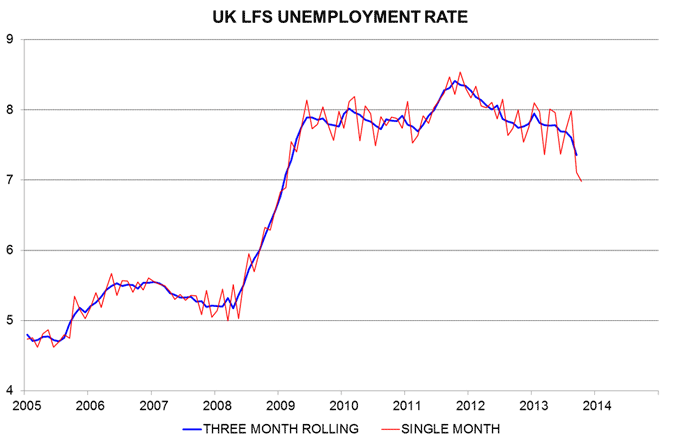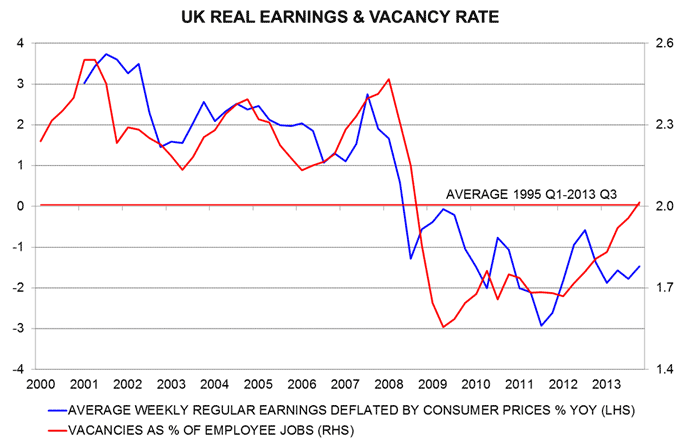UK unemployment could hit 7.0% MPC threshold in 2013
The UK unemployment rate plunged to 7.35% (7.4% rounded) in the three months to October from 7.69% in the prior three months. The single-month estimate for October, moreover, was 6.98%, following 7.10% in September – see first chart. The headline three-month rate, therefore, could hit the MPC’s 7.0% threshold in November or December – at least three years earlier than suggested by the Committee's projections in the August Inflation Report, which accompanied the introduction of forward guidance.
Recent developments are consistent with the view expressed here in July that the unemployment rate was “likely to fall significantly over the remainder of 2013 and, if the trend is sustained, could reach 6.75% in mid-2014”. Such a prospect was obvious from improving trends in job vacancies, business survey labour demand indicators and the claimant count.
Other elements of today’s labour market report were strong. The unemployment fall reflected a surge in employment, while inactivity declined. The alternative workforce jobs measure confirms strong hiring. The employment gain was not dominated by part-timers: average weekly hours were stable. Job vacancies, meanwhile, rose further and the claimant count registered another large monthly decline.
The vacancy rate – i.e. the number of unfilled positions expressed as a percentage of employee jobs – is an employer-based measure of labour market tightness and rose to 2.0% in the three months to November, equal to its average since 1995**. The vacancy rate is positively correlated with the annual rate of change of inflation-adjusted regular earnings: its normalisation suggests that real earnings will resume growth in early 2014 – second chart***.
The return of the vacancy rate to its long-term average casts doubt on the MPC’s estimate that the “medium-term equilibrium unemployment rate” is 6.5%, implying that the actual rate can be allowed to decline well below 7% without generating excessive wage growth.
Aggregate weekly hours worked, meanwhile, rose by 0.9% in the three months to October, roughly matching economic growth – there is no sign, in other words, of the MPC’s assumed productivity revival.
With its unemployment-based forward guidance strategy undermined by another major forecast blunder, the MPC is likely to shift focus to lower-than-expected inflation and sterling strength as excuses for delaying necessary monetary policy tightening.
*The modal and mean projections in the August Report for the third quarter of 2016 were 7.1% and 7.4% respectively.
**The vacancy rate was estimated before the second quarter of 2001 by linking the current employer survey based vacancies series with an earlier series, ending in the first quarter of 2001, covering vacancies at job centres. This linking assumes that 1) the vacancy rate was unchanged between the first and second quarters of 2001 (reasonable – unemployment was little changed between the two quarters) and 2) job centre vacancies were a constant proportion of total vacancies from 1995 to 2001.
***Quarterly data except for the final points, which refer to the latest three months.



Reader Comments